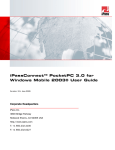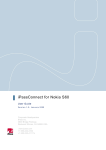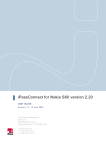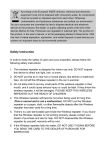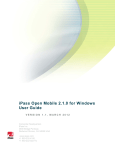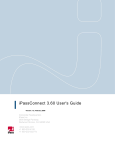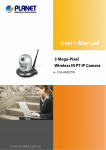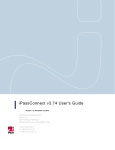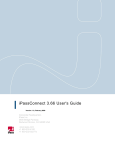Download iPassConnect 3.0 for Mac User's Guide
Transcript
iPassConnect 3.0 for Mac OS X User‟s Guide Version 1.3, March 2009 Corporate Headquarters iPass Inc. 3800 Bridge Parkway Redwood Shores, CA 94065 USA www.ipass.com +1 650-232-4100 +1 650-232-4111 fx T AB LE O F CO NT E NT S Getting Started _______________________________________________________ 4 What is iPassConnect? .............................................................................................................................4 System Requirements ..............................................................................................................................4 Installing iPassConnect ............................................................................................................................5 Uninstalling iPassConnect ........................................................................................................................5 Getting Help ..............................................................................................................................................5 Setting Up iPassConnect ..........................................................................................................................5 Launching iPassConnect .....................................................................................................................6 Available Networks ..............................................................................................................................6 Login Information .................................................................................................................................7 Connecting and Disconnecting .................................................................................................................8 Connecting to a Wi-Fi Network ............................................................................................................9 Connecting to a Non-broadcast Network ............................................................................................9 Disconnecting from a Wi-Fi Network .................................................................................................10 Session Timeout ................................................................................................................................10 About iPassConnect Menu ................................................................................................................10 Using iPassConnect _________________________________________________ 12 Networks Directory .................................................................................................................................12 Updating Directory .............................................................................................................................12 Auto-Connect ..........................................................................................................................................13 Post-Connect Actions .............................................................................................................................14 Preferred Networks .................................................................................................................................15 Changing Configurations ........................................................................................................................17 Support ...................................................................................................................................................18 Connection History ............................................................................................................................18 About iPassConnect ..........................................................................................................................18 Troubleshooting ____________________________________________________ 19 General Troubleshooting Tips ...........................................................................................................19 iPassConnect 3.0 for Mac User’s Guide Version 1.3, Marc h 2009 2009 iPass Inc. Page 2 2 Cop yr igh t © 2 00 9. Al l r ight s r e se rv e d. T rad em a rk s iPass, iPassConnect and the iPass logo are trademarks of iPass Inc. All other brand or product names are trademarks or registered trademarks of their respective companies. W ar r ant y No part of this document may be reproduced, disclosed, electronically distributed, or used without the prior consent of the copyright holder. Use of the software and documentation is governed by the terms and conditions of the iPass Corporate Remote Access Agreement, or Channel Partner Reseller Agreement. Information in this guide is subject to change without notice. Every effort has been made to use fictional companies and locations in this manual. Any actual company names or locations are strictly coincidental and do not constitute endorsement. iPassConnect 3.0 for Mac User’s Guide Version 1.3, Marc h 2009 2009 iPass Inc. Page 3 3 iPassConnect 3.0 for Mac USER‟S GUIDE Getting Started Welcome to iPassConnect 3.0 for Mac OS X! This guide will serve as an introduction to the use of iPassConnect, providing you with information on installation, configuration, basic and advanced usage. What is iPassConnect ? iPassConnect enables you to use your iPass account to login to Wi-Fi networks around the world. The iPassConnect software will bypass the normal authentication required at many of the world‟s public networks and will instead allow you to use your individual or corporate iPass account. iPass is a virtual network operator that has agreements with most of the major network providers around the globe. These agreements allow iPass to offer access to these networks to their customers. Instead of signing up for service with many individual providers, the iPass service lets you subscribe to a single iPass account that gets you access to these hotspot locations in places like Airports, Hotels, and coffee shops. iPassConnect extends the native AirPort functionality available on the Mac platform to make this process simple. When you make a normal AirPort connection to a Wi-Fi network that is part of the iPass family of networks, you are not only connected to that network, but you are also “logged-in” to that network for full Internet access. Without iPassConnect and an iPass account you would have needed to launch a browser and sign-up for an account or purchase a day pass from that individual provider. iPassConnect offers Wi-Fi connectivity to open 802.11 a/b/g/n networks requiring PSK data encryption (WEP, WPA, WPAs, TKIP or AES). The application does not display a separate window or GUI, but presents an AirPort-like userfriendly menu to the Mac user. iPassConnect menu displays a list of networks (SSID) in sorted order, with an iPass logo to identify iPass-enabled networks, signal strength, connection status and a lock indicator to identify networks that require a security key. System Requirements Hardware Requirements iPass recommends the following hardware specifications: Wi-Fi enabled Mac system 5 MB free disk space Supported Platforms iPassConnect 3.0 is supported on the following platform: OS X 10.5 (Leopard) The application has been tested on the following models: MacBook iPassConnect 3.0 for Mac User’s Guide Version 1.3, Marc h 2009 2009 iPass Inc. Page 4 4 MacBook Pro MacBook Air Mac mini iMac Installing iPassConnect Your system must meet system requirements for a successful installation. Please note that you need a username and password with administrator rights in order to perform the installation. To install iPassConnect: 1. Download the software installation package from your company intranet or service provider web site. 2. Double-click the downloaded installer file. 3. The installation wizard is launched. Follow the prompts for installation. Please read and accept the Software License Agreement for the installer to continue. iPass recommends that you install the application in the default location. 4. There will be a brief series of processing steps. Allow the processing to complete, and then iPassConnect will be ready for use. Uninst alling iPassConnect You need a username and password with administrator rights in order to uninstall iPassConnect. To uninstall iPassConnect: 1. Right-click or ctrl-click iPassConnect in the Applications list and choose Show Package Contents to view its contents. 2. Click Uninstall and follow instructions to remove iPassConnect. Getting Help To get help in iPassConnect: 1. Click iPassConnect Help in the iPassConnect menu. 2. Alternately, click the „?’ button on the iPassConnect Preferences dialog box. The help file explains basic iPassConnect settings, procedures and other features. It also contains a troubleshooting section with a basic discussion of the most common issues that could arise when using iPassConnect. For more information, see Support. Setting Up i PassConnect Before using iPassConnect, you should configure iPassConnect with your iPass account information and your basic preferences. This information can be set in the iPassConnect Preferences, which can be accessed either through System Preferences in the „Other‟ section, or if iPassConnect is enabled, under the iPassConnect AirPort icon in the menu bar. iPassConnect 3.0 for Mac User’s Guide Version 1.3, Marc h 2009 2009 iPass Inc. Page 5 5 Launching i PassConnect iPassConnect is automatically launched at boot time. It can also be launched manually as described below. To launch iPassConnect: 1. Click the iPassConnect icon from the Applications list to launch it. iPassConnect displays the following message upon successful launch. 2. Once launched, the iPassConnect icon ( ) is displayed on the menu bar. You can hide the iPassConnect icon and menu if you wish, though iPass does not recommend this. 3. If you attempt to launch iPassConnect when it is already enabled, then the following message is displayed. 4. Finally, this message is displayed if you attempt to launch iPassConnect after it has been disabled using the AirPort only option in the iPassConnect Preferences window. Select appropriate option to proceed further. 5. Click the iPassConnect icon to view the iPassConnect menu and available networks. Availabl e Netw orks iPassConnect can automatically detect local Wi-Fi networks and display them in a list known as Available Networks, making it easy for you to connect to them. The Available Networks listing in your directory will display all accessible wireless networks. iPassConnect 3.0 for Mac User’s Guide Version 1.3, Marc h 2009 2009 iPass Inc. Page 6 6 Select an available network and sign in with valid credentials to initiate a connection. You can use your standard iPass credentials in case of iPass-enabled networks. Obtaining an iPass Account iPass provides service to thousands of corporate customers around the world. Check with your company‟s IT department to see if you already have an account through your employer. If not, you can obtain an individual account by visiting http://www.ipassconnect.com. Login Information Before logging into a network, you must supply a username, password and domain name. If you are an individual subscriber, you should use the username and password assigned to you when you subscribed to the account. If you have a corporate account, the username, password, and domain should be obtained from your IT department. In most cases, it is not necessary to configure a routing prefix. A small percentage of corporate customers utilize a routing prefix instead of a domain setting. iPassConnect can store your login credentials, making it convenient for you to log in. You will need to enter this information only once, prior to using iPassConnect for the first time. A valid username, made up of 40 characters or less in length. A valid password, made up of 15 characters or less in length. A valid domain name, made up of 40 characters or less in length. To set your iPass account information: 1. Click the iPassConnect icon in System Preferences to open iPassConnect Preferences. You can also access iPassConnect Preferences from iPassConnect menu. 2. Click the Login tab. 3. Under Login Information, type your Username, Password and Domain name. Note that some configurations may not have a Domain option in which case the domain name would be pre-set for them. 4. If you want iPassConnect to store your password, select the Save Password check box. 5. Click Apply before closing the Preferences window. iPassConnect 3.0 for Mac User’s Guide Version 1.3, Marc h 2009 2009 iPass Inc. Page 7 7 Connecting and Disconnecting This section outlines connection procedures, including network auto-detection, connecting, and disconnecting. Auto-Detection iPassConnect will automatically detect and display all Wi-Fi networks within range, a process sometimes referred to as sniffing. Auto-detected networks may require valid login credentials for access. If the network is iPassenabled, then your iPass or your corporate account credentials will grant you access. iPassConnect will display detected networks under Available Networks list. iPass enabled access points are distinguished by the icon. You need to manually configure the WLAN settings only in case of non-iPass networks. See Preferred Networks for more information. Network Information The directory displays information about each auto-detected network. Icon Name Description iPass enabled Network This icon represents a iPass enabled network Signal Strength Meter This icon indicates the strength of the wireless signal using blue colored arcs. Secure A lock icon indicates that the network has been secured by a protocol such as WEP, and requires valid credentials in order to connect. iPassConnect 3.0 for Mac User’s Guide Version 1.3, Marc h 2009 2009 iPass Inc. Page 8 8 Icon Name Description Auto-Connect Indicates a network preferred for Auto-Connect. This icon is not displayed in the menu when Auto-Connect has been disabled. Connecting to a Wi-Fi Netw ork iPassConnect supports Wi-Fi connectivity to 802.11 a/b/g/n networks. When the iPassConnect icon is clicked, it scans for all Wi-Fi networks within range and displays the list. The iPassConnect menu displays No Network Selected when you are offline. To connect using iPassConnect: 1. Click the iPassConnect icon to view the Available Networks list. The list is refreshed upon clicking the icon. Wait for the scanning process to complete. Animated icon will be shown to indicate that scanning is in progress. 2. Click the desired network from the list. If you click an iPass-enabled network, then you are logged in automatically, provided you had set your login credentials. If not, the Login Information window is displayed. i. Type your iPass account information - Username, Password and Domain name - in appropriate boxes. ii. Select the Save Password check box if you want iPassConnect to store your password. iii. Click OK. 3. If you clicked a non-iPass enabled network, you might be prompted for credentials and security key. Click OK. 4. Upon connection, iPassConnect displays the connection status window before closing it automatically after a few moments. Once connected, a check mark () is displayed against the network name to identify it. Moreover, the Disconnect option in the iPassConnect menu is enabled. Connecting to a Non -broadcast Netw ork Even though non-broadcast Wi-Fi networks are not displayed in the Available Networks list, you can still connect to these hidden networks provided you have the required information like the Network name and authentication data. iPassConnect 3.0 for Mac User’s Guide Version 1.3, Marc h 2009 2009 iPass Inc. Page 9 9 To connect to a non-broadcast Wi-Fi network using iPassConnect: 1. Click Join Other Network option in the iPassConnect menu. 2. The Preferred Network dialog box is displayed. 3. Key-in the Network Name and other information as needed. 4. Click Join to connect to the specified network. Disconnecting from a Wi -Fi Netw ork You can disconnect from a Wi-Fi network when required. Always remember to disconnect from the network after use. To disconnect using iPassConnect: 1. Click the iPassConnect icon to view the iPassConnect menu. 2. Click Disconnect to disconnect from the Wi-Fi Network. Click the iPassConnect icon to connect again or view the iPassConnect menu. Sessi on Timeout If a session timeout has been defined by the administrator, your connection will be automatically disconnected from the network after the configured timeout period. Session timeout is applicable when connected to iPass hotspot locations. iPassConnect will prompt you with an option to stay connected longer before disconnecting you. About iPassConnect Menu You can view the iPassConnect menu by clicking on the iPassConnect icon in the menu bar. After clicking on this icon, iPassConnect will automatically detect and display all Wi-Fi networks within range. iPassConnect extends the regular AirPort view of these networks to display not just a list of networks detected, but also their signal strength, whether those networks are set for AutoConnect and whether that network name is a part of the iPass family of networks. You can also disable the iPassConnect menu if you so desire, though we do not recommend this. To configure the iPassConnect status on the menu bar: 1. Click iPassConnect Preferences in the iPassConnect menu. Alternately, click the iPassConnect icon in the System Preferences window. 2. Click the Show Status on Menu bar list box to view the following options. iPassConnect 3.0 for Mac User’s Guide Version 1.3, Marc h 2009 2009 iPass Inc. Page 10 1 iPassConnect and Airport: Choose this option to display both iPassConnect ( and AirPort status ( ) on the menu bar. This is the default option. iPassConnect Only: Choose this option to display the iPassConnect status ( while AirPort remains hidden. AirPort Only: Choose this option to display the AirPort status ( iPassConnect remains disabled. ) ) ) while 3. Click Apply before closing the Preferences dialog box. iPassConnect 3.0 for Mac User’s Guide Version 1.3, Marc h 2009 2009 iPass Inc. Page 11 1 Using iPassConnect You can use your Wi-Fi connection to get secure access to both the Internet and your corporate resources. You will need valid credentials in order to log into your selected access point. Your exact iPassConnect capabilities may vary from the general description given here, as different Enterprises may enable different capabilities. Netw orks Director y iPassConnect maintains a directory of network names so it can recognize when you are in range of one of these networks. iPass strives to continually grow their directory of networks and regularly adds new networks to this directory, so you always want to make sure you have the latest directory available to you. iPassConnect automatically updates its networks directory – also called the Phonebook – once a week or as per administrator configured frequency. Updating Directory The iPassConnect directory can be updated both automatically and manually. We recommend that you leave your settings on automatic update. Automatic Update of Directory To configure iPassConnect to update the Directory automatically: 1. From the iPassConnect menu, click iPassConnect Preferences. 2. Click the Updates tab. The Last Update message shows the date of last successful update. 3. Select the Enable automatic updates check box if you wish to enable automatic updates. iPassConnect 3.0 for Mac User’s Guide Version 1.3, Marc h 2009 2009 iPass Inc. Page 12 1 4. Click Apply before closing the Preferences window. Manual Update of Directory A manual update requires that you have already established an Internet connection. To update the Directory manually: 1. On the iPassConnect menu, click iPassConnect Preferences. 2. Click the Updates tab. 3. Click Update button if you wish to update the directory immediately. A status message is displayed once the update is done. Verifying Directory Status You can verify the update status of the directory as follows: 1. Click the iPassConnect icon to view the iPassConnect menu. 2. Click About iPassConnect. 3. The About window displays the product Version number, Profile ID, PhoneBook ID and Last Updated date in addition to Copyright details. Auto-Connect You can configure iPassConnect to automatically initiate a connection to a network – both iPass and non-iPass enabled networks – when it is within signal range. However, note that not all iPass hotspots are eligible for Auto-Connect. Upon launch, iPassConnect checks AirPort's current association and if AirPort is found to be associated with any network, iPassConnect authenticates it automatically. This feature takes precedence over Auto-Connect setting, if any. To enable Auto-Connect: 1. On the iPassConnect menu, click iPassConnect Preferences. iPassConnect 3.0 for Mac User’s Guide Version 1.3, Marc h 2009 2009 iPass Inc. Page 13 1 2. Click the General tab. 3. Select the Enable Auto-Connect check box. 4. Click Apply. To select a Preferred Network for Auto-Connect: 1. On the iPassConnect menu, click iPassConnect Preferences. 2. Click the Preferred Networks tab to view all the networks added to this list. If the network you wish to use is not available in the list, then you can manually add the network. See Preferred Networks for more information. 3. Select the network you wish to enable for Auto-Connect before clicking the edit ( ) button. 4. Select the Enable Auto Connect check box and click Add. 5. Click Apply before closing the Preferences window. Post-Connect Acti ons The Post-Connect Actions feature allows you to configure applications to run after you establish a connection. You may use this feature to launch a Web browser, connect to your corporate network using a VPN solution, or to launch various other applications. To automatically launch your default Web browser after connecting: 1. On the iPassConnect menu, choose iPassConnect Preferences. 2. Click the General tab. 3. Select the Default Web Browser check box. 4. Click Apply. The next time you connect to the Internet, iPassConnect will launch your browser. iPassConnect 3.0 for Mac User’s Guide Version 1.3, Marc h 2009 2009 iPass Inc. Page 14 1 To configure iPassConnect to launch other applications: 1. On the iPassConnect menu, choose iPassConnect Preferences. 2. Click the General tab to view the Post-Connect Actions list. 3. Click the + (add) button to open the Add/Edit Post-Connect Program window. 4. Type an appropriate description for your program in the Description box. 5. Click Browse to locate the program you wish to run. 6. Choose your program from the Applications list and click Open. 7. Add other applications if required, by repeating Steps 3 through 6. 8. Click Apply before closing the Preferences dialog box. The next time you connect, iPassConnect will launch the applications you have specified. To remove applications from the Post-Connect Actions list: 1. On the iPassConnect menu, choose iPassConnect Preferences. 2. Click the General tab to view the Post-Connect Actions list. 3. Select the program from the Launch Program list before clicking the – button. The program is removed from the list. 4. Repeat step 3 to remove other programs as desired. 5. Click Apply before closing the Preferences dialog box. Preferred Netw orks A Preferred Network allows you to easily connect to a network, without going through the preliminary steps. For instance, if you frequent a local coffee shop and wish to use the shop's public WLAN network, you can add it to the Preferred Networks list enabling you to conveniently connect thereafter. Remember that you might need valid login credentials and possibly a security key to connect to these networks. Following connection to an unknown network, the network will be automatically added to the Preferred Network list. If WEP key or WPA pre-shared key information is needed to connect to an unknown network then the client will prompt you for the same and will save the details for use with later connections. You can add, delete, or edit entries in your Preferred Network list. iPass enabled networks cannot be added to Preferred Network list. To add a network to the Preferred Network list: 1. On the iPassConnect menu, click iPassConnect Preferences. iPassConnect 3.0 for Mac User’s Guide Version 1.3, Marc h 2009 2009 iPass Inc. Page 15 1 2. Click the Preferred Networks tab. 3. Click the + (add) button to display the dialog box used to specify the connection details. 4. Type the name of the network in the Network Name box. 5. Select the appropriate Security type from the drop down list box. 6. Type the password in the Password box. Note that the password box is displayed only when you select the security type from the list box. 7. Select the Enable Auto Connect check box if you wish to use this network for Auto-Connect. You have to enable Auto-Connect on the General Preferences tab for this option to be available. 8. Click Add. The network appears in the Preferred Networks list. 9. Click Apply before closing the Preferences window. iPassConnect 3.0 for Mac User’s Guide Version 1.3, Marc h 2009 2009 iPass Inc. Page 16 1 To remove a network from the Preferred Network: 1. On the iPassConnect menu, click iPassConnect Preferences. 2. Click the Preferred Networks tab. 3. Select the network from the list displayed and then click the – (remove) button. The network is removed from the list. 4. Click Apply before closing the Preferences window. To modify settings for a Preferred Network: 1. On the iPassConnect menu, click iPassConnect Preferences. 2. Click the Preferred Networks tab. 3. Select the network from the list displayed before clicking the edit ( ) button. 4. The network details are displayed. Make changes as appropriate and click Add. 5. Click Apply before closing the Preferences window. Changing Configurations Occasionally, your system administrator may want to make some changes to your iPassConnect configuration. In that event, your system administrator will provide you with a configuration code which you can enter through the iPassConnect Preferences. Note that you must be connected to the Internet to do this. To update the configuration: 1. On the iPassConnect menu, choose iPassConnect Preferences. 2. Click the Updates tab. 3. If you have been assigned a new Configuration Code, enter it in the space provided. 4. Click Apply to download a new profile. iPassConnect 3.0 for Mac User’s Guide Version 1.3, Marc h 2009 2009 iPass Inc. Page 17 1 Support This section describes features that can be helpful if you require technical assistance. Connection History The History displays your past connection details, including both successful and unsuccessful attempts to connect. This information can be useful when diagnosing access problems. To view the connection history: 1. Click iPassConnect Preferences in the iPassConnect menu. 2. Click the History tab to view the connection history. The history displays the Date and Time of connection, Network used for connecting, Connection Result, duration of the Session, and Bytes sent/received. 3. If working with your System Administrator or iPass, you may be asked for a copy of your log file for analysis. Click Send Logs in order to send the log via email. About iPassConnect The About iPassConnect dialog box shows the details of your iPassConnect client. You may require this information when dealing with technical support issues. Shown here are: Version: Software version number. Configuration: Profile and Phonebook ID. Copyright details. Last Update: Shows the date on which the directory was last updated. To view the About dialog box: Click iPassConnect About in the iPassConnect menu. iPassConnect 3.0 for Mac User’s Guide Version 1.3, Marc h 2009 2009 iPass Inc. Page 18 1 Troubleshooting This section addresses some of the more common issues that arise when using iPassConnect. If you don't see your issue listed here, or our suggestions fail to resolve your problem, please consult your Help Desk. General Troubleshooting Tips These tips apply to connections in general using iPassConnect. Difficulty Connecting to the Access Point The access point you are connecting through may be inactive or temporarily unavailable. Try another access point in the area. Make sure you have adequate signal strength. A weak signal can lead to failed connections. Make sure you are working away from any obstructions, such as walls, pillars, columns, or other possible sources of interference. Verify the venue is actually an iPass Hotspot - Sometimes an Internet provider will use a network name that is the same as one of the providers that is part of the iPass network, but is not iPass enabled. If possible, verify that the venue is listed in the on-line iPass hotspot directory. The venue may be down or unavailable - Occasionally, some of our service providers can experience technical difficulty. If you are unable to login, try logging in at a different hotspot. Incorrect Password Re-enter your username, domain name and password. Password entry is case-sensitive. Make sure the CAPS LOCK key is not depressed. Make sure you have entered the domain name, such as example.com, in the Domain field of your Login Information window. It is possible that the authentication server may be down or offline. Check with your Help Desk. Your user account may no longer be active. Check with your Help Desk. If using a corporate account, your password may be the same as your domain or email password. If you have recently changed that password, you may also need to change your password in iPassConnect. Password Authentication is Slow In some areas, it may take up to 120 seconds or more to connect. Do not click the Cancel button prematurely. The authentication server may be down or offline. Check with your Help Desk. iPassConnect 3.0 for Mac User’s Guide Version 1.3, Marc h 2009 2009 iPass Inc. Page 19 1



















